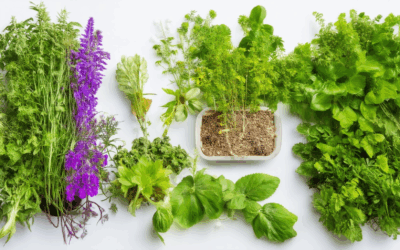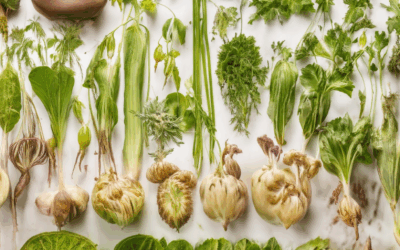Are you eager to learn how to grow your own clean, organic food? Whether you’re a seasoned gardener looking to enhance your practices or a newcomer excited to dive into sustainable living, this guide offers invaluable insights to help you cultivate fresh, nutrient-rich crops right in your backyard. Clean gardening isn’t just a trend—it’s a lifestyle choice that promotes health, sustainability, and a deeper connection with nature. By adopting eco-friendly practices, you can enjoy produce that’s free from harmful pesticides, chemicals, and synthetic additives, ensuring your family enjoys food that’s safer, tastier, and packed with essential nutrients.
Key Takeaways
– Adopt sustainable practices for a thriving garden by incorporating crop rotation, composting, companion planting, vertical gardening, and cover cropping.
– Enhance soil health and reduce chemical reliance through organic composting and natural fertilizers.
– Maximize space and efficiency with vertical gardening while promoting biodiversity and reducing water usage.
– Protect soil integrity and suppress weeds using cover cropping, while attracting pollinators through companion planting.
– Prioritize non-GMO and heirloom seeds for nutrient-dense, flavorful crops and a cleaner food source.
– Minimize chemical exposure by avoiding synthetic pesticides and opting for natural pest control methods.
– Keep tools and containers clean to maintain garden hygiene and ensure produce safety.
– Harvest seasonally and store properly to preserve nutrients and extend freshness.
What Are the Best Practices for Gardening to Grow Clean, Organic Food?
To grow clean, organic food effectively, follow these proven practices:
- Start with Quality Seeds : Begin your gardening journey with high-quality, non-GMO seeds specifically bred for organic production. Look for seeds certified by reputable organizations like the USDA Organic Program or Seed Savers Exchange.
- Prepare Your Soil : Test your soil for pH levels and nutrients. Aim for a pH between 6.0 and 8.0, depending on your crops. Incorporate organic matter like compost or worm castings to enhance soil fertility and structure.
- Composting : Create a compost pile to recycle kitchen scraps and yard waste. Allow the compost to sit for at least six months before use to ensure it’s fully decomposed and free of pathogens.
- Natural Fertilization : Use natural fertilizers such as fish emulsion, bone meal, or seaweed extract. These options provide essential nutrients without harmful chemicals.
- Avoid Synthetic Chemicals : Refrain from using conventional pesticides, herbicides, or synthetic fertilizers. Opt for organic alternatives like neem oil, insecticidal soap, or copper-based fungicides.
- Practice Crop Rotation : Rotate crops to maintain soil health and prevent diseases. Common rotations include vegetables with legumes, followed by root crops, then leafy greens.
- Water Responsibly : Use rainwater or greywater systems to minimize reliance on municipal water supplies. Water deeply and infrequently to encourage strong root growth.
- Encourage Pollinators : Plant flowers and herbs that attract bees, butterflies, and other pollinators. This supports biodiversity and improves crop yields.
- Use Cover Crops : Plant cover crops like clover or rye to protect soil, suppress weeds, and add nitrogen to the soil.
- Harvest Properly : Harvest fruits, vegetables, and herbs at their peak ripeness to maximize flavor and nutrition. Handle produce gently to avoid damage.
By adopting these practices, you can grow clean, organic food that is healthier for you, your family, and the environment. Remember to visit Old Seed for more resources and guides on sustainable gardening techniques.
How to Start Gardening for Clean, Organic Food
Starting your journey into organic gardening is a rewarding experience that allows you to grow fresh, clean, and nutritious food right at home. Whether you have a large backyard or a small balcony, you can create a thriving garden with careful planning and dedication. Here’s a step-by-step guide to help you get started:
1. Plan Your Garden Space
Before you start gardening, it’s essential to plan your space wisely. Consider factors like sunlight exposure, available space, and accessibility. Container gardening is a great option for those with limited room, allowing you to grow plants in any area, from windowsills to patios. Vertical gardening is another space-saving solution, utilizing walls or fences with trellises to maximize your growing area.
2. Prepare Your Soil
A healthy garden starts with healthy soil. Begin by preparing your soil by digging it deeply and incorporating organic matter like compost or manure. Compost improves soil fertility, enriches the soil with nutrients, and helps retain moisture and suppress weeds. Test your soil’s pH levels, especially for plants like tomatoes, which prefer a slightly acidic soil (pH 6.0–7.0).
3. Choose the Right Plants
Select plants that are suited to your climate, soil type, and growing season. For beginners, opt for easy-to-grow vegetables like cucumbers, tomatoes, peppers, and zucchini. These plants are relatively low-maintenance and yield abundant harvests. Herbs such as basil, parsley, and rosemary are also excellent choices for organic gardens.
4. Water Efficiently
Proper watering is crucial for the health of your plants. Use drip irrigation systems to deliver water directly to the roots, reducing waste and preventing overwatering.Mulch around your plants to conserve moisture, regulate soil temperature, and deter weeds. Opt for natural mulches like straw or wood chips.
5. Fertilize Naturally
Instead of chemical fertilizers, use natural options like compost and fish emulsion. Apply compost regularly to maintain soil health and provide essential nutrients. Fish emulsion is a rich source of nitrogen, phosphorus, and potassium, making it ideal for plant growth.
6. Practice Natural Pest Control
Protect your plants from pests using natural methods. Companion planting can help deter pests naturally. For example, marigolds repel aphids and whiteflies, while nasturtiums attract beneficial insects that prey on pests. You can also introduce ladybugs or parasitic wasps to control pest populations.
7. Use Tools and Accessories
Invest in quality gardening tools to make your tasks easier. Wear gloves to protect your skin, use a trowel or small shovel for planting, and consider adding a watering can or a rain barrel to collect and store water efficiently. A wheelbarrow is also a handy tool for moving soil, plants, or supplies.
8. Stay Informed and Educated
Gardening requires continuous learning, so seek out reliable resources to guide you. Join a local gardening club or community garden to connect with experienced growers. Follow reputable gardening blogs, watch instructional videos, and refer to guides from trusted sources like the USDA or your local cooperative extension service.
9. Harvest and Enjoy
As you gain experience, you’ll learn when your plants are ready to harvest. Most vegetables and herbs reach their peak flavor when they mature, usually at sizes you can easily manage. Regular harvesting encourages continued growth and ensures you enjoy fresh, organic produce throughout the growing season.
10. Expand and Improve
Once you feel confident in your gardening skills, you can expand your garden to include more plants and explore new varieties. Experiment with different growing techniques, such as succession planting to extend your growing season or trying your hand at preserving your harvest by freezing, drying, or fermenting.
By following these steps and staying committed to organic practices, you’ll soon be enjoying the fruits of your labor, knowing that your garden is a clean, safe, and productive environment. Happy gardening!
How do you garden for clean, organic produce?
Start with Healthy Soil
We begin by preparing our soil with organic matter like compost and aged manure. This ensures healthy plant growth and a thriving ecosystem in your garden.
Choose Heirloom Seeds
For the freshest and most nutritious produce, we recommend using heirloom seeds from trusted sources like Old Seed . These seeds are open-pollinated, preserving genetic diversity and offering superior flavor and resilience.
Practice Sustainable Practices
Embrace crop rotation and companion planting to maintain soil health and deter pests. This method mimics natural ecosystems and promotes biodiversity, ensuring a balanced garden environment.
Opt for Natural Pest Control
Instead of synthetic pesticides, we rely on natural predators like ladybugs and birds. Regularly inspect plants and introduce beneficial insects to maintain harmony in your garden.
Water Wisely
Use rainwater collection systems or mulch to retain moisture in the soil. This reduces water usage and prevents overwatering, which can harm plants and reduce yields.
Support Local Farmers
When possible, purchase organic produce from local farmers or CSA programs. This supports sustainable farming practices and ensures your fruits and vegetables are fresh and free from harmful chemicals.
Preserve Genetic Diversity
Save seeds from your garden to contribute to heirloom preservation efforts. By doing so, you help protect rare varieties and promote sustainable agriculture for future generations.
- Composting: Enhances soil fertility and reduces waste. (Learn more at Old Seed .)
- Sustainable Watering: Use drip irrigation to conserve water and prevent runoff.
- Natural Fertilizers: Opt for fish emulsion or worm castings for nutrient-rich plant food.
- Organic Pesticides: Use neem oil or insecticidal soap as safe alternatives to synthetic chemicals.
- Local Harvesting: Enjoy seasonal produce at its peak flavor and nutritional value.
By adopting these practices, we can all work towards growing clean, organic produce and supporting sustainable farming methods.
Best Methods for Growing Clean, Organic Food
Growing clean, organic food requires a combination of sustainable practices, knowledge of gardening techniques, and dedication to maintaining healthy ecosystems. Here are some of the most effective methods to achieve this:
- Crop Rotation
- Composting
- Companion Planting
- Vertical Gardening
- Cover Cropping
Each of these methods contributes to producing clean, organic food while promoting environmental health. By adopting these practices, you can ensure your garden thrives without harmful chemicals.
Crop Rotation
Crop rotation involves planting different crops in successive seasons to maintain soil fertility and prevent pests. This method enhances biodiversity and ensures that nutrients are replenished naturally. For example, planting tomatoes one year followed by peppers the next helps balance the soil pH levels.
Composting
Composting is a simple yet powerful technique that transforms kitchen scraps and yard waste into nutrient-rich soil amendments. By creating a compost pile, you can enrich your soil organically, reducing the need for synthetic fertilizers. Regularly turning the pile accelerates decomposition and maximizes its benefits.
Companion Planting
Companion planting pairs plants together based on their complementary needs. For instance, marigolds deter pests, while basil enhances the flavor of tomatoes. This method promotes pollinator attraction and creates a balanced garden ecosystem.
Vertical Gardening
Vertical gardening is an excellent space-saving solution that allows you to grow a variety of crops. Using structures like trellises or hanging baskets, you can maximize your garden’s potential while saving water and space. Herbs, vegetables, and flowers can all thrive in vertical setups.
Cover Cropping
Cover cropping involves planting fast-growing cover crops during the off-season to protect soil, suppress weeds, and improve moisture retention. Clover, vetch, and rye are popular choices that enhance soil health and prepare it for the next planting season.
By implementing these methods, you can grow clean, organic food while contributing to a healthier planet. Whether you’re a seasoned gardener or just starting out, these practices will lead to bountiful harvests and a more sustainable lifestyle.
Key Tips for Growing Clean, Healthy Food
Eating clean starts with your garden, and at Old Seed, we believe in cultivating more than just plants—we’re growing a healthier lifestyle for you and your family.
1. Use Organic Compost and Amendments
Composting isn’t just for waste management—it’s a cornerstone of clean gardening. By using organic materials like kitchen scraps, coffee grounds, and manure, you’ll enrich your soil naturally. A balanced compost pile can suppress pathogens and promote beneficial microorganisms, ensuring your plants grow strong and your food stays clean.
2. Practice Crop Rotation
Rotating crops helps maintain soil health and prevents diseases. For instance, planting tomatoes one year and peppers the next avoids overexposing your garden to pests or fungi. This simple technique also improves nutrient availability and keeps your food safer and cleaner.
3. Water Wisely and Less Frequently
Overwatering can lead to disease-prone plants and nutrient leaching. Instead, water deeply but less often, allowing the soil to absorb moisture slowly. This method reduces runoff and keeps your plants healthier, which translates to cleaner, more nutritious produce.
4. Choose Non-GMO and Heirloom Seeds
When selecting seeds, opt for non-GMO varieties to avoid harmful chemicals and genetically modified organisms. Heirloom seeds offer unique flavors and adaptability, ensuring your harvest is as diverse as it is clean. At Old Seed, we specialize in preserving these traditional varieties for future generations.
5. Implement Companion Planting
Plants don’t just grow independently—they can support each other through companion planting. For example, marigolds deter pests, while basil enhances tomato growth. These relationships not only boost yields but also reduce the need for synthetic pesticides, keeping your garden—and your food—cleaner.
6. Avoid Synthetic Pesticides and Chemical Fertilizers
Synthetic pesticides and fertilizers can leave residues on your plants, which may transfer to your food. Instead, rely on natural methods like composting, crop rotation, and biological controls to maintain balance in your garden. This approach ensures cleaner, healthier crops and aligns with sustainable practices.
Additional Tips for Cleaner Gardening
- Use Reusable Containers: Store seeds and tools in breathable containers to prevent moisture buildup and prolong germination success.
- Sanitize Tools Regularly: Keep your gardening tools sharp and free from dirt to minimize the risk of transferring pathogens to your plants and produce.
- Store Harvested Goods Properly: Use clean, food-grade containers to store your crops, ensuring they remain fresh and safe for consumption.
By adopting these practices, you’ll not only enjoy cleaner, healthier food but also contribute to a more sustainable future. At Old Seed, we’re dedicated to helping you grow your best garden yet—naturally and organically.
Ready to get started? Explore our comprehensive gardening guides and discover more ways to grow clean, healthy food.
What Are the Key Steps to Garden for Clean, Organic Food?
Old Seed advocates for a holistic approach to gardening that prioritizes sustainability and health. By following these organized steps, you can successfully grow clean, organic food while nurturing the environment:
- 1. Prepare Your Soil:** Test your soil for pH levels and nutrients. Mix compost, aged manure, or fish emulsion into the soil to enrich it naturally.
- 2. Choose the Right Plants:** Select heirloom or open-pollinated varieties known for their hardiness and nutrient density. These plants thrive in organic conditions and are free from synthetic chemicals.
- 3. Implement Sustainable Practices:** Use companion planting to deter pests and promote biodiversity. Rotate crops to maintain soil health and prevent diseases.
- 4. Use Natural Fertilizers:** Opt for compost, worm castings, or seaweed-based fertilizers instead of chemical alternatives. These methods enhance soil structure and plant growth.
- 5. Control Pests Naturally:** Introduce beneficial insects or use barriers like copper tape to repel pests. Avoid harmful pesticides that harm beneficial organisms.
- 6. Water Efficiently:** Use rainwater collection systems or mulch to retain moisture in the soil, reducing the need for frequent watering.
- 7. Maintain Diversity:** Plant a variety of vegetables, flowers, and herbs to create a balanced ecosystem that supports pollinators and reduces disease spread.
- 8. Harvest Seasonally:** Collect fruits, vegetables, and herbs at their peak to preserve nutrients and flavors. Store crops properly to extend their shelf life.
- 9. Share and Educate:** Share your harvest with neighbors or local communities. Educate others about the benefits of organic gardening and sustainable practices.
- 10. Continuous Improvement:** Regularly test your gardening methods and adapt based on seasonal changes or feedback from your plants.
By adopting these steps, you can enjoy fresh, clean, and organic food while contributing to a healthier planet. Explore more tips and resources on Old Seed’s comprehensive guide to sustainable gardening.
For more insights, check out our Sustainable Agriculture Blog and discover how to maintain a thriving organic garden year-round.








0 Comments